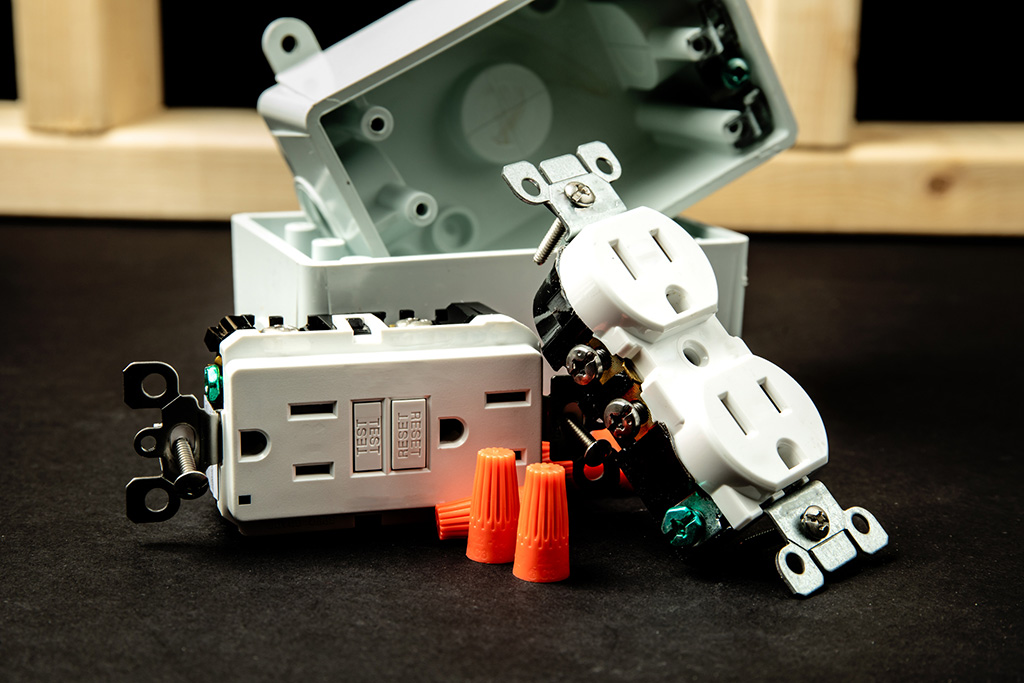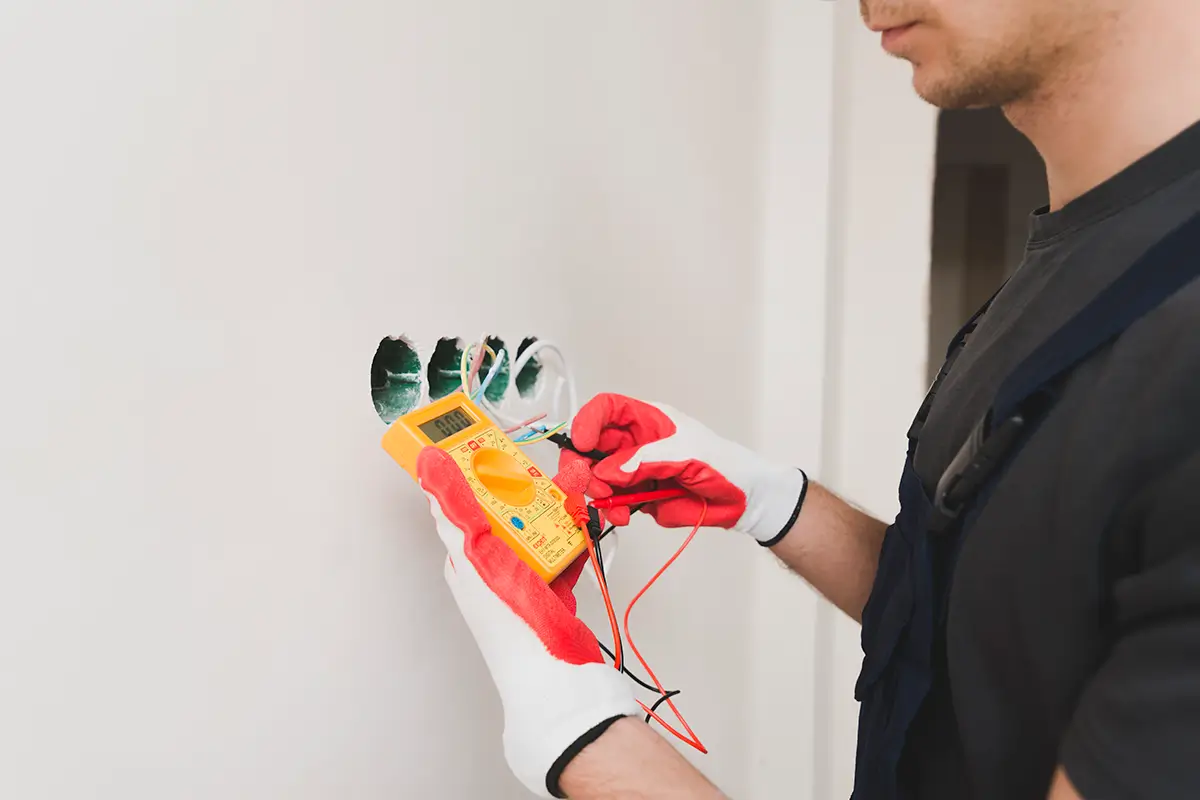You know those outlets in bathrooms, kitchens, and outdoor areas with the little buttons labeled “reset” and “test”? Those handy devices are called GFCI outlets, and they ensure safety when it comes to your home’s electrical system. Building codes actually require GFCI protection in lots of areas we’ll cover shortly.
But what exactly is a GFCI outlet? Today, we’ll peel back the curtain on these essential safety devices. We’ll explore what they are, how they work their life-saving magic, and why they’re so crucial for home safety.
We’ll also dive into where they need to be installed, how to tell if yours is working properly, and whether you can take a DIY approach to installing them. Let’s dive into the wonderful world of GFCI outlets!

What Is a GFCI Outlet?
A GFCI (Ground Fault Circuit Interrupter) outlet is a specialized type of electrical outlet that monitors the flow of electric current in a circuit. Sounds pretty fancy, right? But don’t worry, we’ll break it down.
Per Section E3902 of the New York State Residential Code, a GFCI is required in areas like bathrooms, kitchens, laundry rooms, garages, crawlspaces, and outdoors. But what makes it so special? Well, a GFCI outlet has a nifty built-in sensor that continuously tracks the amount of current flowing into the circuit compared to what’s returning.
If there’s even a tiny discrepancy between those values – we’re talking just 4-6 milliamps of leakage – the GFCI outlet recognizes that as a ground fault. Ground faults can allow electrical current to find an unintended path, like through your body, which could lead to electrical shock or electrocution.
The second that minuscule current discrepancy is detected, the GFCI reacts in a split second by cutting off power to that circuit. This prevents that leaking current from potentially flowing through someone and causing serious injury or worse. Pretty brilliant for such a small device!
You’ve probably noticed the “reset” and “test” buttons on GFCI outlets. They’re not just for decoration – they actually serve an important purpose in keeping the GFCI functioning properly.
The “reset” button does just what it says – it resets the GFCI outlet and allows power to flow to whatever is plugged into it after it has tripped. Hitting reset is necessary after the GFCI has detected a ground fault and cut off power to that circuit as a safety measure.
But how do you know if your GFCI is working correctly? That’s where the “test” button comes in. Pushing the test button intentionally creates that small current discrepancy that simulates a ground fault. If the GFCI is operating correctly, it should immediately cut power when you press test.
Testing your GFCIs every month using that button ensures they can detect real ground faults and cut power fast enough to keep you safe. If pressing “test” doesn’t cause the GFCI to trip and cut power, that’s an indication it may be malfunctioning and needs to be replaced.
How Does a GFCI Outlet Work?
Now that we know what a GFCI outlet is and why those reset/test buttons are so important, let’s peek under the hood at how these little life-savers actually work their magic.
Inside every GFCI outlet is an important component called a circuit breaker. But this isn’t your run-of-the-mill circuit breaker like the big ones in your electrical panel. The GFCI circuit breaker is specially engineered with an extra winding of conductive material that acts as a sensor.
As electricity flows from the GFCI outlet through the hot and neutral wires to whatever is plugged in, it creates a magnetic field that is monitored by that sensor winding. Under normal circumstances, the magnetic fields created by the current going out through the hot wire and the current returning through the neutral wire are equal and opposite. This is how things should operate.
However, if a ground fault occurs where the electrical current starts leaking elsewhere, it creates an imbalance in those magnetic fields. That sensor winding detects this imbalance instantly. As soon as the difference between those two fields reaches that 4-6 milliamp threshold, the GFCI outlet’s circuit breaker is triggered to cut power within 1/40th of a second!
This makes the GFCI able to respond to ground faults far faster than a standard circuit breaker. That tiny window of response time is absolutely crucial for preventing that leaking current from potentially flowing through a person and delivering a severe electric shock.
Pretty clever how that sensor winding and circuit breaker work in tandem to provide such effective, split-second protection! GFCIs are like a sentry standing guard for ground fault dangers 24/7.
Why are GFCI Outlets Important for Home Safety?
With their built-in ground fault detection and lightning-fast reaction time, it’s clear GFCIs offer excellent protection against electrical shocks. But just how crucial are these devices for home safety?
The risk of electrical shocks is higher than many people realize, especially in areas exposed to moisture like bathrooms, kitchens, laundry rooms, basements, garages, and outdoors. When water and electricity mix, it creates the perfect storm for ground faults to occur where current can find an unintended path to ground through your body.
Even a small amount of stray electrical current is extremely dangerous and can deliver a shock intense enough to cause burns, nerve damage, and even stop your heart. Without GFCI protection, touching an appliance or fixture during a ground fault could potentially send a fatal dose of electricity through your body.
GFCIs provide an affordable, effective safeguard against these kinds of hazardous electric shock scenarios. Their ability to detect and respond to leaking current in a split second dramatically reduces the risk of serious injury or electrocution.
For homes with young children or elderly residents who may be less able to react quickly to an electrical danger, GFCIs add an essential layer of protection. They operate automatically without requiring someone to be alert enough to spot a problem and shut off power quickly.
Building codes recognize how vital GFCI technology is by mandating its installation in numerous areas of the home prone to ground fault risks. GFCIs provide reliable, proven shock prevention that helps electricians and inspectors feel confident a home’s wiring meets the highest modern safety standards.
So while GFCIs may seem simple, these mighty outlets play an incredibly important role in guarding against one of home electrical systems’ most serious hazards. For homeowners, they deliver invaluable peace of mind.
Where Should GFCI Outlets Be Installed in a Home?
We’ve covered what GFCIs are and why they are so vital for home electrical safety. But where exactly should these protective outlets be installed according to safety codes? Let’s dig into the requirements.
As outlined in Section E3902 of the New York State Residential Code, GFCI protection is mandatory for 125-volt, 15- and 20-amp receptacles in numerous areas prone to ground fault risks:
- Bathrooms: All bathroom receptacles must have GFCI protection to guard against shocks with water present.
- Garages and accessory buildings: Any outlets in attached garages or grade-level areas of detached buildings used for storage or work require GFCIs.
- Outdoors: All outdoor outlets of 125-volts or less must have GFCI protection since they are exposed to weather and moisture.
- Crawl spaces: Outlets and lighting fixtures in unfinished crawl spaces at or below grade level need GFCIs installed.
- Unfinished basements: Any 125V receptacles in non-living areas of unfinished basements fall under the GFCI requirement.
- Kitchens: GFCI protection is needed for all countertop receptacles in kitchens where shock risks are higher.
- Within 6 feet of sinks: Outlets installed within this radius of the outside edge of any sink must be GFCI-protected.
- Laundry areas: Outlets in laundry rooms need GFCIs since water and electricity are present.
The codes also specify GFCI protection for dishwasher branch circuits, boat houses, boat hoists, and electric heating cables installed on potentially damp floors.
As you can see, the requirements are quite extensive when it comes to installing GFCIs in areas where electrical equipment could potentially encounter moisture and create ground fault hazards. This broad coverage is why GFCIs are such an essential electrical safety feature in any modern home.
What’s the Difference Between a GFCI Outlet and a Regular Outlet?
Now that we understand where GFCIs need to be installed, you may be wondering – what sets them apart from a regular electrical outlet? The difference comes down to that built-in ground fault protection.
A standard outlet provides a basic connection point for plugging in appliances, electronics, and other devices to an electrical circuit. It has no safeguards against ground faults or electrical leakage.
A GFCI outlet, on the other hand, contains that specialized internal circuit breaker and sensor winding that continuously monitors for ground faults and leaking current. If a ground fault occurs, the GFCI can quickly detect the hazardous situation and cut power before a lethal dose of electricity has a chance to reach someone.
This capability to respond in as little as 1/40th of a second to shut off the flow of electricity sets GFCI outlets far apart from their standard counterparts in terms of shock protection. A regular outlet would keep supplying power during a ground fault until someone is able to locate the circuit breaker and shut it off manually.
You can also easily identify GFCI outlets by the “reset” and “test” buttons on the front. These allow you to reset the GFCI after it has tripped due to detecting a ground fault, as well as manually test that it can still correctly sense a leakage scenario and cut power.
While GFCI outlets have this sophisticated safety functionality, they can still be used just like a normal outlet for powering devices and appliances in dry, grounded areas. The ground fault protection is always active in the background providing an invisible security blanket in case of electrical dangers.
So in summary – a GFCI is a standard outlet with the amazing shock-preventing superpowers of ground fault sensing and automated power cut-off. For areas with moisture risks, they are well worth the added protection.
Can I Install a GFCI Outlet Myself?
With their straightforward installation in a standard outlet box, you may be wondering if installing a GFCI outlet is a DIY project you can tackle yourself. The answer is – it can be, but there are some important caveats to consider.
If you have experience working with electrical wiring and outlets, installing a GFCI isn’t much more complicated than switching out a regular receptacle. The outlet itself will have wiring diagrams to ensure you connect the line, neutral, ground, and load cables correctly.
However, a critical part of GFCI installation is ensuring it is wired properly to protect the downstream portion of the circuit it is supplying power to. Simply replacing an old outlet with a GFCI does not extend that ground fault protection throughout the circuit.
To cover everything downstream from the GFCI location, it needs to be wired as the first outlet on the circuit run. This allows its sensing and shutdown capabilities to safeguard any other outlets, light fixtures, or hardwired devices further along that branch circuit.
If not installed correctly as the first outlet, a GFCI may only protect itself and anything plugged directly into it, defeating the purpose of whole-circuit ground fault safety. Precise wiring is key.
There are also building code requirements around GFCI installation that need to be followed, such as them being readily accessible after install. With the risks of shocks and code violations, many homeowners opt to hire a licensed electrician for GFCI projects unless they have significant prior electrical experience.
If you do choose to install a GFCI outlet yourself, be sure to thoroughly research proper wiring methods and safety procedures. And always be sure to shut off the breaker and verify the circuit is dead before ANY electrical work. With care and the right knowledge, DIY GFCI installation can be done – but hire a pro if you have any doubts.
Are There Any Alternatives to GFCI Outlets?
While GFCI outlets provide excellent ground fault protection at the point of use, there are a couple of alternative ways to implement this life-saving technology throughout a home’s electrical system.
GFCI Circuit Breakers
Instead of installing individual GFCI receptacles, you can get the same ground fault protection by replacing a standard circuit breaker in your electrical panel with a GFCI circuit breaker. This option allows the built-in ground fault sensing to cover that entire branch circuit right from the breaker box.
GFCI circuit breakers work exactly like GFCI outlets – continuously monitoring for leakage and cutting power if a 4-6 milliamp ground fault is detected. However, they protect everything supplied by that circuit without needing GFCIs at every outlet location.
This can be a convenient solution for covering multiple outlets, lighting, and hard-wired devices on the same branch circuit. It also allows for very easy reset by just flipping the breaker switch instead of going outlet-to-outlet.
GFCI Deadfront Construction
For new home construction, some areas allow the installation method known as “GFCI deadfront” to provide blanket ground fault protection. This involves installing a special GFCI receptacle as the first outlet in a circuit, with all the other receptacles on that run being standard non-GFCI types.
As long as the circuit after the first GFCI outlet meets certain wiring technique requirements outlined in section E3902.16 of the residential code, the GFCI will then sense and cut power for ground faults occurring anywhere further down that branch circuit’s run.
While not as comprehensive as a GFCI circuit breaker, this allows for the same whole-circuit GFCI protection but at a lower product cost than installing individual GFCIs at every single outlet location.
Of course, both of these alternatives still require precise installation by an electrician to ensure they are properly configured and wired to detect ground faults consistently. But they do provide more flexible options beyond just individual GFCI outlets depending on your home’s setup and budget.
You Can Count on Reimer’s Expertise for GFCI Safety
After learning all about GFCI outlets and why they’re so crucial for home electrical safety, you may be feeling ready to upgrade or want some professionals to ensure your home is properly protected. When it comes to GFCI installation, inspection, and replacement, the experts at Reimer have been Western New York’s go-to for over 100 years.
Founded in 1921, Reimer has built a reputation across generations of homeowners for friendly, honest service and unmatched expertise. Our certified electricians know GFCI systems inside and out – from meticulous outlet installations and circuitry wiring to whole-home solutions utilizing GFCI circuit breakers. We ensure every GFCI is installed and functioning per current safety codes.
Whether you need a few new outlets put in, want to verify existing GFCIs are still offering full protection, or are interested in exploring alternatives like deadfront construction, Reimer has you covered. We’ll take the time to understand your home’s specific needs and provide an upfront, fair estimate for the work.
Best of all, Reimer stands behind our work with a 100% satisfaction guarantee. If you’re not completely happy, we’ll make it right – that’s just how we’ve operated for a century of service. When your family’s safety is on the line, you deserve that extra peace of mind.
Ready to keep your loved ones protected from ground fault dangers? Give our friendly team a call at (716) 272-2371 to schedule your GFCI installation or inspection. We’re here for you day or night with top-notch service from trained professionals you can trust. Experience the Reimer difference!





